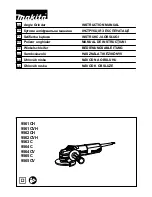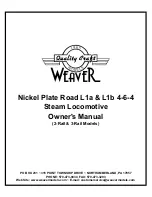
that is is free and non-binding.
Since the pushrods are exposed, you may wish to give
them a coat of the same material that you used for the
fuselage framework to protect them from spent fuel.
PRE-FLIGHT INSTRUCTIONS
This section assumes that your Elder is completely
done, covered, painted as needed, etc. We are now going
to establish the correct C.G. (Center of Gravity). Start by
completely assembling the airplane. Note on the plans
that the mark shown for the C.G. point is directly over the
spars and directly beneath the top mating point of the
"king-post". Slip a length of string under the kingpost
and lift the airplane off your bench. The airplane, ideally,
should hang suspended either level or slightly nose-
down. This would mean that the C.G. is where it should
be to provide you with a stable flying airplane.
If the tail hangs low, some of the equipment has to be
moved forward. Remember, this balance is always
achieved without fuel in the tank—that's burn-off
weight and cannot be counted. The easiest component
to move is the battery pack. Depending on the pack's
configuration, it can be installed beneath the fuel tank. If
you still need more weight forward, slide the servo tray
all the way forward as far as it will go. If more weight is
needed (highly unlikely) then you will have to add lead
weight in the nose, beneath the tank. If you have to add
lead, don't worry, the Elder will still fly quite well.
If the airplane is nose-heavy, then try moving the servo
tray back as far as it will go, etc... Once the airplane
hangs suspended as it should, you will have to now glue
the servo tray permanently in place against the 1/4"x1/2"
balsa bearers that it rests on.
Prior to flying, get in the habit of making a complete
check of the airframe. Is the prop tight?. Batteries in
both the airplane and transmitter fully charged? Engine
bolts tight? All components firmly attached to each
other? Fuel lines clear? Wheels roll easily? Make a radio
system check as well—up is up, down is down and the
throttle moves in the right direction. You're ready to fly!
FLYING INSTRUCTIONS
Once again, if this is your first R/C aircraft DO NOT AT-
TEMPT TO FLY IT YOURSELF. Go to your local hobby
shop and get information about any local flying clubs in
your area. It is within such groups that knowledgeable,
experienced individuals can be found to assist you.
Assuming that the radio system (airborne and transmit-
ter) are fully charged and that your engine is completely
broken-in and reliable, let's fly! Fill the tank and turn the
radio system on. With the engine running at idle, point
the Elder directly into the wind and advance the throttle
slowly. With most "tail-draggers" a small amount of
right rudder will be needed to keep the airplane on a
straight heading. With a little experience you will be able
to keep the take-off roll quite straight. As the speed
picks-up, the tail will lift and in a short time the airplane
will lift-off. Keep the plane headed straight with the nose
in a shallow climb—do not "horse" it up with excess up
elevator, that is the beginning of a "snap roll" and at low
altitude this can quickly become a crash!
Once sufficient altitude is reached (75'-100'), try some
turns to get used to the handling characteristics. Non-
aileron equipped models react a little slower in theturns
and these turns tend to the "skidding" type. If all of the
homework was correctly done on the ground, your Elder
should be flying quite nicely. While at altitude, try the
throttle and get used to the slow-speed characteristics
of the airplane before setting-up your landing. Use the
transmitter trims to correct for any unwanted climbing,
diving or turning tendencies from straight and level
flight at cruise speeds. Like most aircraft that have flat-
bottom airfoils, the Elder will naturally want to climb at
full power and settle at low throttle. A point somewhere
in between these two throttle settings will provide the
"cruise" speed. This setting will vary according to a.) the
engine size and b.) the finished weight of your model.
With some flying time experience you will find that the
Elder is quite aerobatic; loops from level flight, left and
right snap rolls, left and right spins with almost instant
recovery. Inverted flight is possible with practice.
Landings can be as slow and predictable as you'd like,
just maintain your heading into the wind all the way
through touch-down and roll-out to a stop. We have
found that the Elder steers quite well on the ground with
deflected rudder and short bursts of power—be sure
you're holding full-up elevator while you are doing this.
We sincerely hope that this has been a good project for
you and that the hours on the building board will be
rewarded with many, many enjoyable flights.
INDEX
INTRODUCTION . . . . . . . . . . . . . . . . . . . . . . . . . . . . 1
PRE-CONSTRUCTION NOTES . . . . . . . . . . . . . . . . . 2
WING ASSEMBLY . . . . . . . . . . . . . . . . . . . . . . . . . . . 2
T A I L G R O U P . . . . . . . . . . . . . . . . . . . . . . . . . . . . . . . . 4
FUSELAGEASSEMBLY. . . . . . . . . . . . . . . . . . . . . . . 5
LANDINGGEARANDTAILSKIDASSEMBLY ..... 8
FINALASSEMBLY ........................... 8
COVERINGANDFINISH . . . . . . . . . . . . . . . . . . . . . . 9
RADIO INSTALLATION . . . . . . . . . . . . . . . . . . . . . . . 11
P R E - F L I G H T . . . . . . . . . . . . . . . . . . . . . . . . . . . . . . . . 12
FLYING . . . . . . . . . . . . . . . . . . . . . . . . . . . . . . . . . . . . 12
12
150083






























